Analyzing Intel Core M Performance: How 5Y10 can beat 5Y71 & the OEMs' Dilemma
by Brett Howse & Ian Cutress on April 8, 2015 8:00 AM ESTPCMark 8 Creative Results
The Creative suite for PCMark changes the workloads out a bit, and is overall a much longer benchmark. Creative includes web browsing, photo editing, video editing, group video chat, media transcoding, and gaming workloads, so like the previous test the higher resolution of the Yoga 3 Pro will bring its scores down compared to the 1080p of all of the other devices. Like PCMark 8 Home, the work features high demand followed by low demand.
The Core i5 performs much the same as during the Home benchmark. Clearly the cooling system which is designed to get rid of 15 watts of heat can pretty easily cope with these types of workloads, and it even allows the CPU to turbo quite often to the CPU’s maximum speed of 2.7 GHz. GPU workloads are also no issue for the cooling system. None of the 4.5 watt TDP devices fare so well though, and as with the Home benchmark we see the Yoga 3 Pro having quite good CPU and GPU frequencies. The Dell is limited quite a bit more on temperature, and the ASUS is limited by its lack of maximum turbo frequency.
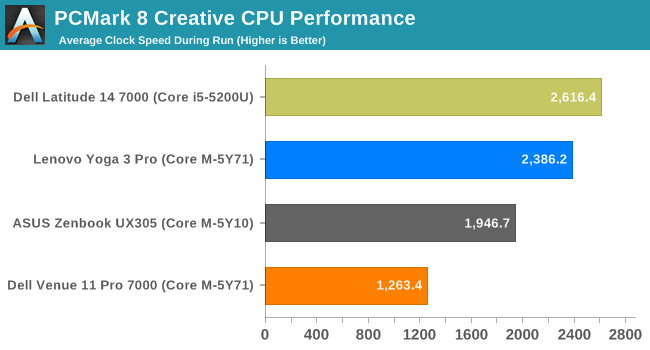
Looking at the average CPU frequency tells a big story of thermal limitations on the Dell Venue 11 Pro. With an average that is barely over its base of 1.2 GHz, the device spends a significant amount of time below its base frequency. The UX305 keeps its consistency high, with it almost reaching its maximum turbo clock, while the Yoga 3 Pro ends up quite a bit faster.
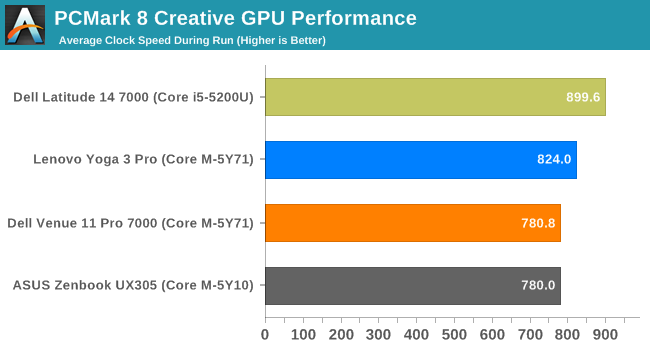
The GPU story has the ASUS bumping into its maximum GPU speed of 800 MHz, keeping pace with the Dell Venue 11 Pro which can go as high as 900 MHz. The Yoga 3 Pro is over 800 Mhz, here, showcasing its active cooling solution and meaning it is certainly spending time closer to its 900 MHz GPU turbo.
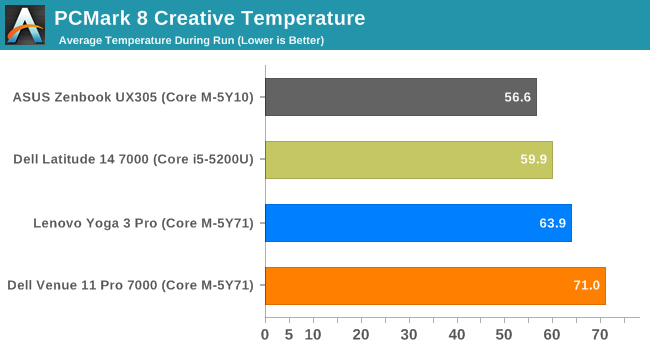
Looking at average temperatures, it is obvious why the ASUS can stay close to its maximum turbo on many workloads. After this one hour benchmark, the CPU average was just over 56°C despite the passive cooling. The active cooled Broadwell-U laptop is a bit higher, and the Yoga 3 Pro kept its average under its 65°C CPU maximum.
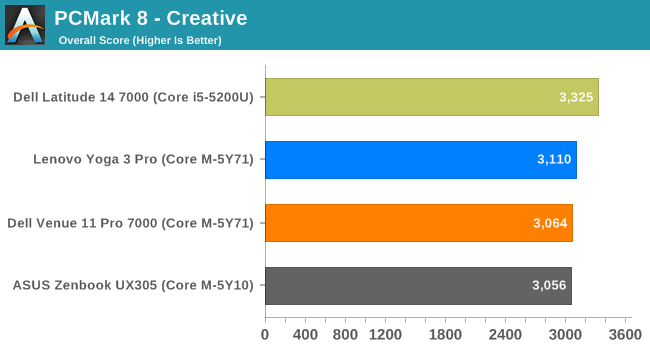
The Lenovo Yoga 3 Pro scores the highest of all three Core M devices in this benchmark despite the higher resolution display. On this type of workload where the actual work is much shorter, it keeps its CPU frequency much higher than all of the other Core M devices. The Venue 11 Pro also outscores the UX305 despite its low average CPU frequency. When needed, it was able to turbo well past the 2 GHz maximum of the 5Y10 device.


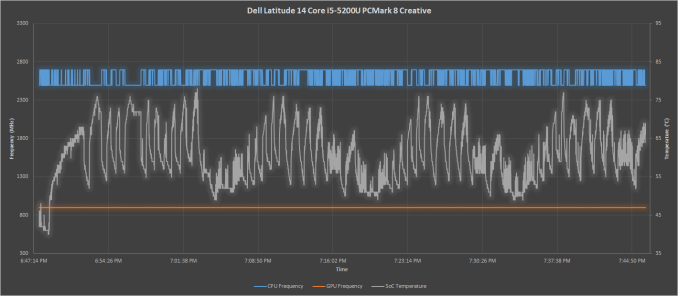
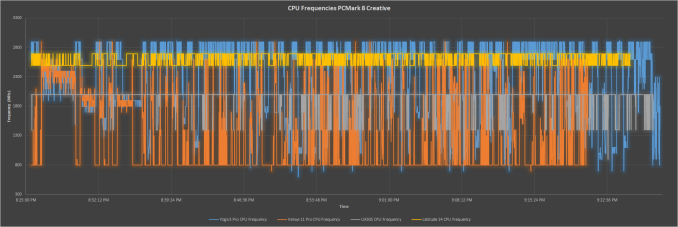
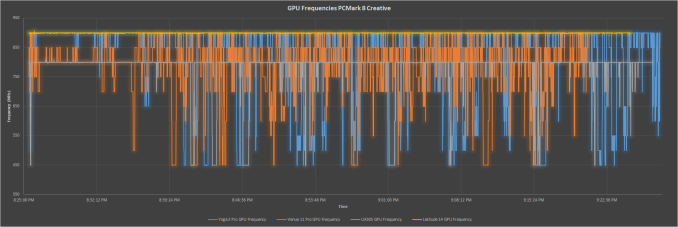
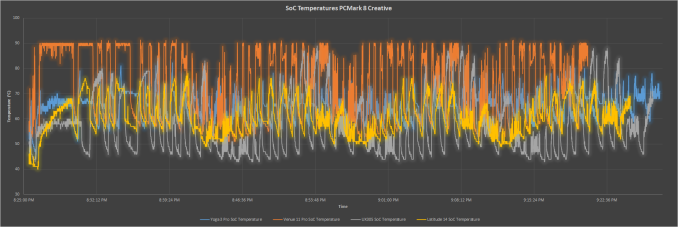








110 Comments
View All Comments
zepi - Wednesday, April 8, 2015 - link
Surface pro 3 is ~50% thicker than iPad Air 2, weights ~50% more, has active cooling and still has poorer performance than Surface Pro 2.From my point of view Surface pro 3 proves that Haswell-U can't power ultra-thin x86 tablets.
lilmoe - Wednesday, April 8, 2015 - link
Didn't know the iPad was an ultra-thin x86 tablet that replace your laptop. Good to know, thanks.I get that the iPad has a huge fan base, I really do. But would you guys please stop comparing it to real PCs in tablet form already??
zepi - Thursday, April 9, 2015 - link
Central argument proposed was that SP3 somehow proves that Haswell-U can power ultra-thin X86 tablets. There were no mentions about Windows or OSX compatibility in original statement.Keyword is Tablet. x86, ultra-thin etc. are describe terms. You don't need to go far and see that the statement is clearly false. Ultra-thin in context of tablets means these days that thickness of the device should to be somewhere around 6-7mm. SP3 is 9mm. I picked iPad Air 2, because it is the most well known of competitors. We could just as well use Dell Venue 8. Ipad thickness is 6.1 and Dell is 6mm thick. Later is even x86 and runs windows
Weight was another thing. Naturally comparing weight to Venue 8 makes very little sense since SP3 has over twice the total screen area of Venue 8 so I compare it with iPad air 2, which has the biggest screen area of the most well known tablets in the market. Most certainly, there are some less well known 12" models, but they are not widely spread and have hardly any market penetration.
I cannot see how SP3 would prove that 15w TDP allows for compact tablet designs. SP3 is already thermally limited and mostly proves to me that in order to reach smaller and thinner designs, lower power SOC's are necessary. From my point of view SP3 is full computer which offers decent (though arguably best in class) tablet usability in addition of being dockable general purpose PC-computer.
digiguy - Wednesday, April 8, 2015 - link
come on, you change the comparison in the same sentence, SP3 is thinner and lighter than SP2, and has has higher res screen. As for ipad air, try to run Windows on it....Jaybus - Wednesday, April 8, 2015 - link
Or even if it ran OSX. The iPad is a giant iPhone. If it ran OSX, then we could compare it to SP3. For now, iPad can only be compared to Android tablets.xthetenth - Wednesday, April 8, 2015 - link
Being thicker than slower devices and slower than thicker devices only proves that it fits between them on a size/performance scale and does nothing to show that it's not a good device.ppi - Wednesday, April 8, 2015 - link
My desktop is also thicker than iPaid Air2, weighs more, has active cooling and certainly eats more power. So ... ?You have to realize, that this 4.5W chip actually has performance that is in league with 15W chip. For many ultrabook/2-in-1 use cases ideal chip. And read the Yoga3 review, where on CPU-bound benchmarks, Core-M runs circles around A8X.
frozentundra123456 - Wednesday, April 8, 2015 - link
I agree with some of the other posters. The problem is the price of these devices for the performance. I can see them for say business use, where the company is paying, use is light, and mobility is important (say for a sales rep who travels a lot), but otherwise, I cant see Joe Average Consumer paying north of 1000 for these when you can get similar perrformance for less in a 350.00 conventional laptop or less performance, but still decent in a 100 to 300 dollar atom device.xthetenth - Wednesday, April 8, 2015 - link
The ASUS is in the 700 dollar range and avoids a great many other compromises cheaper devices would make. It fits into the price/quality scale very nicely.zepi - Wednesday, April 8, 2015 - link
From gaming / usability perspective the average-results do not necessarily tell enough.Ie. does the usage experience of certain devices suffer because GPU / CPU throttles too much under certain loads?
Are the bottom 10% frametimes so horrendous on throttling devices that DOTA-gaming is practically out of question despite relatively small difference in average frame rates?